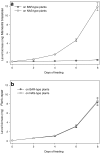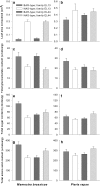Barbarea vulgaris glucosinolate phenotypes differentially affect performance and preference of two different species of lepidopteran herbivores
- PMID: 18213497
- PMCID: PMC2239252
- DOI: 10.1007/s10886-007-9424-9
Barbarea vulgaris glucosinolate phenotypes differentially affect performance and preference of two different species of lepidopteran herbivores
Abstract
The composition of secondary metabolites and the nutritional value of a plant both determine herbivore preference and performance. The genetically determined glucosinolate pattern of Barbarea vulgaris can be dominated by either glucobarbarin (BAR-type) or by gluconasturtiin (NAS-type). Because of the structural differences, these glucosinolates may have different effects on herbivores. We compared the two Barbarea chemotypes with regards to the preference and performance of two lepidopteran herbivores, using Mamestra brassicae as a generalist and Pieris rapae as a specialist. The generalist and specialist herbivores did not prefer either chemotype for oviposition. However, larvae of the generalist M. brassicae preferred to feed and performed best on NAS-type plants. On NAS-type plants, 100% of the M. brassicae larvae survived while growing exponentially, whereas on BAR-type plants, M. brassicae larvae showed little growth and a mortality of 37.5%. In contrast to M. brassicae, the larval preference and performance of the specialist P. rapae was unaffected by plant chemotype. Total levels of glucosinolates, water soluble sugars, and amino acids of B. vulgaris could not explain the poor preference and performance of M. brassicae on BAR-type plants. Our results suggest that difference in glucosinolate chemical structure is responsible for the differential effects of the B. vulgaris chemotypes on the generalist herbivore.
Figures




Similar articles
-
The Role of the Glucosinolate-Myrosinase System in Mediating Greater Resistance of Barbarea verna than B. vulgaris to Mamestra brassicae Larvae.J Chem Ecol. 2018 Dec;44(12):1190-1205. doi: 10.1007/s10886-018-1016-3. Epub 2018 Sep 14. J Chem Ecol. 2018. PMID: 30218254
-
Oviposition Preference for Young Plants by the Large Cabbage Butterfly (Pieris brassicae ) Does not Strongly Correlate with Caterpillar Performance.J Chem Ecol. 2017 Jun;43(6):617-629. doi: 10.1007/s10886-017-0853-9. Epub 2017 Jun 15. J Chem Ecol. 2017. PMID: 28620771 Free PMC article.
-
Early season herbivore differentially affects plant defence responses to subsequently colonizing herbivores and their abundance in the field.Mol Ecol. 2008 Jul;17(14):3352-65. doi: 10.1111/j.1365-294X.2008.03838.x. Epub 2008 Jun 28. Mol Ecol. 2008. PMID: 18565114
-
Role of Saponins in Plant Defense Against Specialist Herbivores.Molecules. 2019 May 30;24(11):2067. doi: 10.3390/molecules24112067. Molecules. 2019. PMID: 31151268 Free PMC article. Review.
-
Insect herbivore counteradaptations to the plant glucosinolate-myrosinase system.Phytochemistry. 2011 Sep;72(13):1566-75. doi: 10.1016/j.phytochem.2011.01.016. Epub 2011 Feb 10. Phytochemistry. 2011. PMID: 21316065 Review.
Cited by
-
Tri-trophic effects of inter- and intra-population variation in defence chemistry of wild cabbage (Brassica oleracea).Oecologia. 2011 Jun;166(2):421-31. doi: 10.1007/s00442-010-1861-4. Epub 2010 Dec 8. Oecologia. 2011. PMID: 21140168 Free PMC article.
-
Interactions of Bunias orientalis plant chemotypes and fungal pathogens with different host specificity in vivo and in vitro.Sci Rep. 2020 Jul 1;10(1):10750. doi: 10.1038/s41598-020-67600-7. Sci Rep. 2020. PMID: 32612111 Free PMC article.
-
Resistance in the plant, Barbarea vulgaris, and counter-adaptations in flea beetles mediated by saponins.J Chem Ecol. 2010 Mar;36(3):277-85. doi: 10.1007/s10886-010-9758-6. Epub 2010 Feb 23. J Chem Ecol. 2010. PMID: 20177743
-
Interactions of a medicinal climber Tinospora cordifolia with supportive interspecific plants trigger the modulation in its secondary metabolic profiles.Sci Rep. 2019 Oct 4;9(1):14327. doi: 10.1038/s41598-019-50801-0. Sci Rep. 2019. PMID: 31586109 Free PMC article.
-
Population-related variation in plant defense more strongly affects survival of an herbivore than its solitary parasitoid wasp.J Chem Ecol. 2011 Oct;37(10):1081-90. doi: 10.1007/s10886-011-0024-3. Epub 2011 Oct 11. J Chem Ecol. 2011. PMID: 21987026 Free PMC article.
References
-
- {'text': '', 'ref_index': 1, 'ids': [{'type': 'DOI', 'value': '10.1023/A:1024217504445', 'is_inner': False, 'url': 'https://doi.org/10.1023/a:1024217504445'}, {'type': 'PubMed', 'value': '12918925', 'is_inner': True, 'url': 'https://pubmed.ncbi.nlm.nih.gov/12918925/'}]}
- Agerbirk, N., Olsen, C. E., Bibby, B. M., Frandsen, H. O., Brown, L. D., Nielsen, J. K., and enwick, J. A. A. 2003a. A saponin correlated with variable resistance of Barbarea vulgaris to the diamondback moth Plutella xylostella. J. Chem. Ecol. 29:1417–1433. - PubMed
-
- {'text': '', 'ref_index': 1, 'ids': [{'type': 'DOI', 'value': '10.1016/S0031-9422(02)00750-1', 'is_inner': False, 'url': 'https://doi.org/10.1016/s0031-9422(02)00750-1'}, {'type': 'PubMed', 'value': '12657300', 'is_inner': True, 'url': 'https://pubmed.ncbi.nlm.nih.gov/12657300/'}]}
- Agerbirk, N., Orgaard, M., and Nielsen, J. K. 2003b. Glucosinolates, flea beetle resistance, and leaf pubescence as taxonomic characters in the genus Barbarea (Brassicaceae). Phytochemistry 63:69–80. - PubMed
-
- {'text': '', 'ref_index': 1, 'ids': [{'type': 'DOI', 'value': '10.1021/jf001256r', 'is_inner': False, 'url': 'https://doi.org/10.1021/jf001256r'}, {'type': 'PubMed', 'value': '11312886', 'is_inner': True, 'url': 'https://pubmed.ncbi.nlm.nih.gov/11312886/'}]}
- Agerbirk, N., Petersen, B. L., Olsen, C. E., Halkier, B. A., and Nielsen, J. K. 2001. 1,4-Dimethoxyglucobrassicin in Barbarea and 4-hydroxyglucobrassicin in Arabidopsis and Brassica. J. Agric. Food Chem. 49:1502–1507. - PubMed
-
- {'text': '', 'ref_index': 1, 'ids': [{'type': 'DOI', 'value': '10.1111/j.2006.0030-1299.15025.x', 'is_inner': False, 'url': 'https://doi.org/10.1111/j.2006.0030-1299.15025.x'}]}
- Agosta, S. J. 2006. On ecological fitting, plant-insect associations, herbivore host shifts, and host plant selection. Oikos 114:556–565.
-
- {'text': '', 'ref_index': 1, 'ids': [{'type': 'DOI', 'value': '10.1023/A:1020821823794', 'is_inner': False, 'url': 'https://doi.org/10.1023/a:1020821823794'}]}
- Agrawal, A. A., Gorski, P. M., and Tallamy, D. W. 1999. Polymorphism in plant defense against herbivory: Constitutive and induced resistance in Cucumis sativus. J. Chem. Ecol. 25:2285–2304.
Publication types
MeSH terms
Substances
LinkOut - more resources
Full Text Sources

